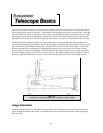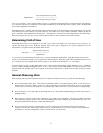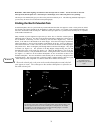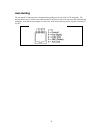36
D
D
e
e
c
c
l
l
i
i
n
n
a
a
t
t
i
i
o
o
n
n
D
D
r
r
i
i
f
f
t
t
M
M
e
e
t
t
h
h
o
o
d
d
o
o
f
f
P
P
o
o
l
l
a
a
r
r
A
A
l
l
i
i
g
g
n
n
m
m
e
e
n
n
t
t
This method of polar alignment allows you to get the most accurate alignment on the celestial pole and is required if
you want to do long exposure deep-sky astrophotography through the telescope. The declination drift method requires
that you monitor the drift of selected stars. The drift of each star tells you how far away the polar axis is pointing from
the true celestial pole and in what direction. Although declination drift is simple and straight-forward, it requires a
great deal of time and patience to complete when first attempted. The declination drift method should be done after
any one of the previously mentioned methods has been completed.
To perform the declination drift method you need to choose two bright stars. One should be near the eastern horizon
and one due south near the meridian. Both stars should be near the celestial equator (i.e., 0° declination). You will
monitor the drift of each star one at a time and in declination only. While monitoring a star on the meridian, any
misalignment in the east-west direction is revealed. While monitoring a star near the east/west horizon, any
misalignment in the north-south direction is revealed. It is helpful to have an illuminated reticle eyepiece to help you
recognize any drift. For very close alignment, a Barlow lens is also recommended since it increases the magnification
and reveals any drift faster. When looking due south, insert the diagonal so the eyepiece points straight up. Insert the
cross hair eyepiece and align the cross hairs so that one is parallel to the declination axis and the other is parallel to the
right ascension axis. Move your telescope manually in R.A. and DEC to check parallelism.
First, choose your star near where the celestial equator and the meridian meet. The star should be approximately within
1/2 an hour of the meridian and within five degrees of the celestial equator. Center the star in the field of your
telescope and monitor the drift in declination.
• If the star drifts south, the polar axis is too far east.
• If the star drifts north, the polar axis is too far west.
Make the appropriate adjustments to the polar axis to eliminate any drift. Once you have eliminated all the drift, move
to the star near the eastern horizon. The star should be 20 degrees above the horizon and within five degrees of the
celestial equator.
• If the star drifts south, the polar axis is too low.
• If the star drifts north, the polar axis is too high.
Again, make the appropriate adjustments to the polar axis to eliminate any drift. Unfortunately, the latter adjustments
interact with the prior adjustments ever so slightly. So, repeat the process again to improve the accuracy checking both
axes for minimal drift. Once the drift has been eliminated, the telescope is very accurately aligned. You can now do
prime focus deep-sky astrophotography for long periods.
NOTE: If the eastern horizon is blocked, you may choose a star near the western horizon, but you must reverse the
polar high/low error directions. Also, if using this method in the southern hemisphere, the direction of drift is
reversed for both R.A. and DEC.


















